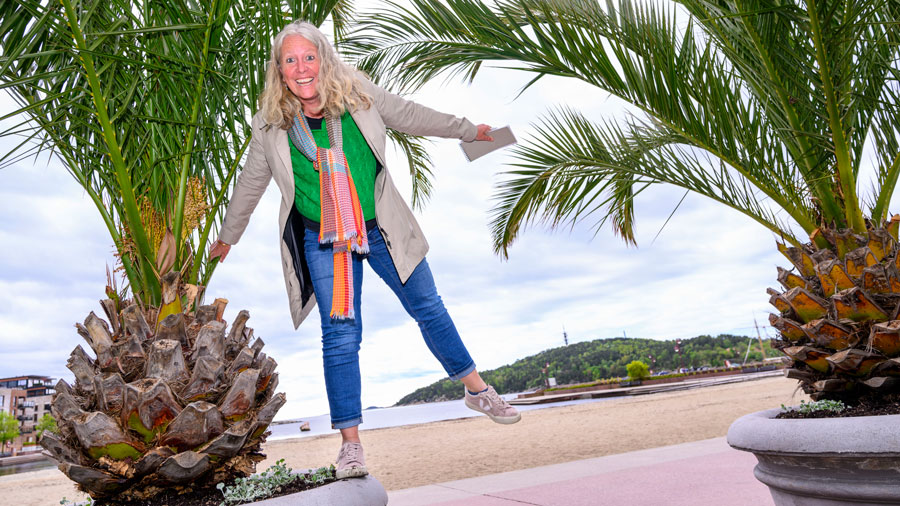In this piece
The potential for constructive journalism in trade union reporting

The right mixture of straight and constructive reporting may give readers a more balanced world view, says Ingeborg Vigerust Rangul. (Image: Kjell Inge Søreide)
In this piece
What is constructive journalism? | What are the problems that constructive journalism seeks to address? | Where is it working? | What does constructive journalism look like at Fagbladet? | ConclusionConstructive journalism, an emerging approach within the media landscape, seeks to balance traditional reporting by not only highlighting societal problems but also showcasing solutions and progress. This is the lifeblood of trade unionism.
As a journalist at Fagbladet, a trade union magazine serving public sector workers in Norway, I wanted to explore this methodology's potential to enhance our reporting and better serve our audience.
Fagbladet serves members of Fagforbundet, the largest trade union in Norway, representing a wide range of public sector professions. Our mission is to provide credible journalism that increases members’ knowledge of their profession, showcases the importance of their work, and offers a platform for addressing injustice and bias.
We believe in highlighting stories that not only focus on problems but also on the remarkable results achieved by individuals despite challenges.
What is constructive journalism?
Constructive journalism is about reporting what works in society through a critical lens. It’s not about replacing investigative journalism or focusing solely on “feel good” news. Rather, it aims to provide a more balanced view by covering responses to problems, thereby shifting the focal point from issues to solutions.
Ida Løvdahl Alvsen, a doctoral candidate at Nord University, emphasises that constructive journalism means “seeing the world with both eyes” instead of just one. The Constructive Institute at Aarhus University, founded by Danish journalist Ulrik Haagerup, supports this by promoting rigorous and critical reporting on both problems and progress.
Despite its potential, constructive journalism faces challenges due to a lack of conceptual precision. As Peter Bro from the Centre for Journalism at Syddansk University notes, early proponents did little to clarify the concept, leading to varied interpretations and practices. This vagueness has sometimes resulted in criticisms of being overly optimistic or lacking critical analysis.
What are the problems that constructive journalism seeks to address?
Constructive journalism aims to tackle several critical issues within the media landscape.
News avoidance: Richard Fletcher, who co-authored the 2024 Reuters Digital News Report, told me their data show 31% of Norwegian news consumers avoid news often or sometimes, up from 23% the previous year. Constructive journalism seeks to engage these avoiders by providing inspiring and solution-focused content.
Negative psychological impact: Continuous exposure to negative news can lead to "mean world syndrome," where audiences perceive the world as more dangerous than it is. Constructive journalism mitigates this by offering a balanced view.
Trust in media: In an era of “fake news” and polarisation, constructive journalism helps rebuild trust between news outlets and their audiences by providing empowering and balanced news.
Where is it working?
To understand how constructive journalism can be successfully implemented, I spoke to editors in Norway, Sweden, and Finland, among other countries.
Norway: Interactive constructivism: NRK, Norway’s public broadcaster, aims to be a leader in constructive journalism in the Nordic region. Project leader Benedicte Fjelly highlights the importance of creating dialogue with the public. An example is their coverage of the Salvation Army’s food bank queues, where audience suggestions were gathered and presented to local politicians, fostering a productive dialogue.
Sweden: Highlighting individual counter forces: Eva Landahl from SVT, the Swedish national broadcaster, focuses on highlighting counter forces to societal issues. SVT’s constructive pieces often cover local efforts to solve problems, thereby presenting a more nuanced and human-centred perspective.
Finland: Starting with a problem, looking to the future At Yle, Finland’s national broadcaster, constructive journalism starts with a clear problem and looks towards future solutions. Jonas Jungar emphasises that constructive journalism should not be about “nice” stories but should relate to significant social challenges.
What does constructive journalism look like at Fagbladet?
At Fagbladet, we ensure our constructive journalism efforts maintain objectivity. Our editor, Eva Ler Nilsen, stresses the importance of not tipping into activism and keeping a critical eye even on our own publisher.
One example of our constructive journalism is our coverage of working hours in Heim municipality. By highlighting innovative measures that increased full-time health personnel from 35% to 70% overnight, we showcased how solutions can be implemented successfully without compromising journalistic integrity.
What I’ve come to realise during my time at the Reuters Institute is that many of the stories I thought were constructive were not. True constructive journalism should:
- Address a fundamental societal problem.
- Present a solution that is already under way.
- Include critical examination of the solution.
To uncover potential constructive angles, journalists should ask themselves:
- What are the possible constructive scenarios?
- Can we highlight solutions and counter forces?
- Is there a way to involve the audience in finding solutions?
Many interviewees also stressed the importance of having dedicated personnel in the newsroom who specialise in asking these questions and taking responsibility for constructive journalism.
Conclusion
Constructive journalism represents an evolution in the field, aiming to provide a more balanced and hopeful view of the world. By incorporating solutions and positive developments into our reporting, we can engage audiences, build trust, and promote informed public debate. This approach is not about replacing traditional journalism but enhancing it by showing what works alongside what doesn’t.
As we continue to refine our practice at Fagbladet, I hope we will inspire other newsrooms to adopt this balanced approach, ultimately fostering a more informed and empowered society.
This article summarises the main points of Ingeborg Vigerust Rangul’s project. Download the full project PDF below.



